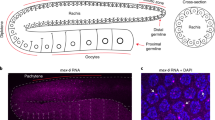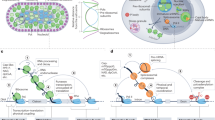Abstract
Many Saccharomyces cerevisiae genes encode antisense transcripts, some of which are unstable and degraded by the exosome component Rrp6. Loss of Rrp6 results in the accumulation of long PHO84 antisense (AS) RNAs and repression of sense transcription through PHO84 promoter deacetylation. We used single-molecule resolution fluorescent in situ hybridization (smFISH) to investigate antisense-mediated transcription regulation. We show that PHO84 AS RNA acts as a bimodal switch, in which continuous, low-frequency antisense transcription represses sense expression within individual cells. Surprisingly, antisense RNAs do not accumulate at the PHO84 gene but are exported to the cytoplasm. Furthermore, rather than stabilizing PHO84 AS RNA, the loss of Rrp6 favors its elongation by reducing early transcription termination by Nrd1–Nab3–Sen1. These observations suggest that PHO84 silencing results from antisense transcription through the promoter rather than the static accumulation of antisense RNAs at the repressed gene.
This is a preview of subscription content, access via your institution
Access options
Subscribe to this journal
Receive 12 print issues and online access
$189.00 per year
only $15.75 per issue
Buy this article
- Purchase on Springer Link
- Instant access to full article PDF
Prices may be subject to local taxes which are calculated during checkout






Similar content being viewed by others
References
Neil, H. et al. Widespread bidirectional promoters are the major source of cryptic transcripts in yeast. Nature 457, 1038–1042 (2009).
David, L. et al. A high-resolution map of transcription in the yeast genome. Proc. Natl. Acad. Sci. USA 103, 5320–5325 (2006).
Xu, Z. et al. Bidirectional promoters generate pervasive transcription in yeast. Nature 457, 1033–1037 (2009).
Jacquier, A. The complex eukaryotic transcriptome: unexpected pervasive transcription and novel small RNAs. Nat. Rev. Genet. 10, 833–844 (2009).
Houseley, J. & Tollervey, D. The many pathways of RNA degradation. Cell 136, 763–776 (2009).
LaCava, J. et al. RNA degradation by the exosome is promoted by a nuclear polyadenylation complex. Cell 121, 713–724 (2005).
Thiebaut, M., Kisseleva-Romanova, E., Rougemaille, M., Boulay, J. & Libri, D. Transcription termination and nuclear degradation of cryptic unstable transcripts: a role for the nrd1-nab3 pathway in genome surveillance. Mol. Cell 23, 853–864 (2006).
Vanácová, S. et al. A new yeast poly(A) polymerase complex involved in RNA quality control. PLoS Biol. 3, e189 (2005).
Wyers, F. et al. Cryptic pol II transcripts are degraded by a nuclear quality control pathway involving a new poly(A) polymerase. Cell 121, 725–737 (2005).
Arigo, J.T., Eyler, D.E., Carroll, K.L. & Corden, J.L. Termination of cryptic unstable transcripts is directed by yeast RNA-binding proteins Nrd1 and Nab3. Mol. Cell 23, 841–851 (2006).
Vasiljeva, L. & Buratowski, S. Nrd1 interacts with the nuclear exosome for 3′ processing of RNA polymerase II transcripts. Mol. Cell 21, 239–248 (2006).
Carroll, K.L., Ghirlando, R., Ames, J.M. & Corden, J.L. Interaction of yeast RNA-binding proteins Nrd1 and Nab3 with RNA polymerase II terminator elements. RNA 13, 361–373 (2007).
Steinmetz, E.J., Conrad, N.K., Brow, D.A. & Corden, J.L. RNA-binding protein Nrd1 directs poly(A)-independent 3′-end formation of RNA polymerase II transcripts. Nature 413, 327–331 (2001).
Gudipati, R.K., Villa, T., Boulay, J. & Libri, D. Phosphorylation of the RNA polymerase II C-terminal domain dictates transcription termination choice. Nat. Struct. Mol. Biol. 15, 786–794 (2008).
Kim, H. et al. Gene-specific RNA polymerase II phosphorylation and the CTD code. Nat. Struct. Mol. Biol. 17, 1279–1286 (2010).
Vasiljeva, L., Kim, M., Mutschler, H., Buratowski, S. & Meinhart, A. The Nrd1–Nab3–Sen1 termination complex interacts with the Ser5-phosphorylated RNA polymerase II C-terminal domain. Nat. Struct. Mol. Biol. 15, 795–804 (2008).
Xu, Z. et al. Antisense expression increases gene expression variability and locus interdependency. Mol. Syst. Biol. 7, 468 (2011).
Murray, S.C. et al. A pre-initiation complex at the 3′-end of genes drives antisense transcription independent of divergent sense transcription. Nucleic Acids Res. 40, 2432–2444 (2012).
Tisseur, M., Kwapisz, M. & Morillon, A. Pervasive transcription—Lessons from yeast. Biochimie 93, 1889–1896 (2011).
Hainer, S.J., Pruneski, J.A., Mitchell, R.D., Monteverde, R.M. & Martens, J.A. Intergenic transcription causes repression by directing nucleosome assembly. Genes Dev. 25, 29–40 (2011).
Martens, J.A., Laprade, L. & Winston, F. Intergenic transcription is required to repress the Saccharomyces cerevisiae SER3 gene. Nature 429, 571–574 (2004).
Thiebaut, M. et al. Futile cycle of transcription initiation and termination modulates the response to nucleotide shortage in S. cerevisiae. Mol. Cell 31, 671–682 (2008).
Bumgarner, S.L. et al. Single-cell analysis reveals that noncoding RNAs contribute to clonal heterogeneity by modulating transcription factor recruitment. Mol. Cell 45, 470–482 (2012).
van Werven, F.J. et al. Transcription of two long noncoding RNAs mediates mating-type control of gametogenesis in budding yeast. Cell 150, 1170–1181 (2012).
Gelfand, B. et al. Regulated antisense transcription controls expression of cell-type-specific genes in yeast. Mol. Cell Biol. 31, 1701–1709 (2011).
Hongay, C.F., Grisafi, P.L., Galitski, T. & Fink, G.R. Antisense transcription controls cell fate in Saccharomyces cerevisiae. Cell 127, 735–745 (2006).
Houseley, J., Rubbi, L., Grunstein, M., Tollervey, D. & Vogelauer, M. A ncRNA modulates histone modification and mRNA induction in the yeast GAL gene cluster. Mol. Cell 32, 685–695 (2008).
Pinskaya, M., Gourvennec, S. & Morillon, A. H3 lysine 4 di- and tri-methylation deposited by cryptic transcription attenuates promoter activation. EMBO J. 28, 1697–1707 (2009).
Kim, T., Xu, Z., Clauder-Munster, S., Steinmetz, L.M. & Buratowski, S. Set3 HDAC mediates effects of overlapping noncoding transcription on gene induction kinetics. Cell 150, 1158–1169 (2012).
Weiner, A. et al. Systematic dissection of roles for chromatin regulators in a yeast stress response. PLoS Biol. 10, e1001369 (2012).
Komeili, A. & O'Shea, E.K. Roles of phosphorylation sites in regulating activity of the transcription factor Pho4. Science 284, 977–980 (1999).
Lam, F.H., Steger, D.J. & O'Shea, E.K. Chromatin decouples promoter threshold from dynamic range. Nature 453, 246–250 (2008).
Wippo, C.J. et al. Differential cofactor requirements for histone eviction from two nucleosomes at the yeast PHO84 promoter are determined by intrinsic nucleosome stability. Mol. Cell Biol. 29, 2960–2981 (2009).
Camblong, J., Iglesias, N., Fickentscher, C., Dieppois, G. & Stutz, F. Antisense RNA stabilization induces transcriptional gene silencing via histone deacetylation in S. cerevisiae. Cell 131, 706–717 (2007).
Femino, A.M., Fay, F.S., Fogarty, K. & Singer, R.H. Visualization of single RNA transcripts in situ. Science 280, 585–590 (1998).
Zenklusen, D., Larson, D.R. & Singer, R.H. Single-RNA counting reveals alternative modes of gene expression in yeast. Nat. Struct. Mol. Biol. 15, 1263–1271 (2008).
Raj, A., van den Bogaard, P., Rifkin, S.A., van Oudenaarden, A. & Tyagi, S. Imaging individual mRNA molecules using multiple singly labeled probes. Nat. Methods 5, 877–879 (2008).
Zenklusen, D. & Singer, R.H. Analyzing mRNA expression using single mRNA resolution fluorescent in situ hybridization. Methods Enzymol. 470, 641–659 (2010).
Oeffinger, M. & Zenklusen, D. To the pore and through the pore: a story of mRNA export kinetics. Biochim. Biophys. Acta 1819, 494–506 (2012).
Rougemaille, M. et al. Dissecting mechanisms of nuclear mRNA surveillance in THO/sub2 complex mutants. EMBO J. 26, 2317–2326 (2007).
Nonet, M., Scafe, C., Sexton, J. & Young, R. Eucaryotic RNA polymerase conditional mutant that rapidly ceases mRNA synthesis. Mol. Cell Biol. 7, 1602–1611 (1987).
Grigull, J., Mnaimneh, S., Pootoolal, J., Robinson, M.D. & Hughes, T.R. Genome-wide analysis of mRNA stability using transcription inhibitors and microarrays reveals posttranscriptional control of ribosome biogenesis factors. Mol. Cell Biol. 24, 5534–5547 (2004).
Krogan, N.J. et al. The Paf1 complex is required for histone H3 methylation by COMPASS and Dot1p: linking transcriptional elongation to histone methylation. Mol. Cell 11, 721–729 (2003).
Ng, H.H., Robert, F., Young, R.A. & Struhl, K. Targeted recruitment of Set1 histone methylase by elongating Pol II provides a localized mark and memory of recent transcriptional activity. Mol. Cell 11, 709–719 (2003).
Creamer, T.J. et al. Transcriptome-wide binding sites for components of the Saccharomyces cerevisiae non-poly(A) termination pathway: Nrd1, Nab3, and Sen1. PLoS Genet. 7, e1002329 (2011).
Wlotzka, W., Kudla, G., Granneman, S. & Tollervey, D. The nuclear RNA polymerase II surveillance system targets polymerase III transcripts. EMBO J. 30, 1790–1803 (2011).
Soares, L.M. & Buratowski, S. Yeast Swd2 is essential because of antagonism between Set1 histone methyltransferase complex and APT (associated with Pta1) termination factor. J. Biol. Chem. 287, 15219–15231 (2012).
Camblong, J. et al. Trans-acting antisense RNAs mediate transcriptional gene cosuppression in S. cerevisiae. Genes Dev. 23, 1534–1545 (2009).
Margaritis, T. et al. Two distinct repressive mechanisms for histone 3 lysine 4 methylation through promoting 3′-end antisense transcription. PLoS Genet. 8, e1002952 (2012).
Grzechnik, P. & Kufel, J. Polyadenylation linked to transcription termination directs the processing of snoRNA precursors in yeast. Mol. Cell 32, 247–258 (2008).
Gudipati, R.K. et al. Extensive degradation of RNA precursors by the exosome in wild-type cells. Mol. Cell 48, 409–421 (2012).
Darby, M.M., Serebreni, L., Pan, X., Boeke, J.D. & Corden, J.L. The S. cerevisiae Nrd1-Nab3 transcription termination pathway acts in opposition to Ras signaling and mediates response to nutrient depletion. Mol. Cell Biol. 32, 1762–1775 (2012).
Lardenois, A. et al. Execution of the meiotic noncoding RNA expression program and the onset of gametogenesis in yeast require the conserved exosome subunit Rrp6. Proc. Natl. Acad. Sci. USA 108, 1058–1063 (2011).
van Dijk, E.L. et al. XUTs are a class of Xrn1-sensitive antisense regulatory non-coding RNA in yeast. Nature 475, 114–117 (2011).
Buratowski, S. & Kim, T. The role of cotranscriptional histone methylations. Cold Spring Harb. Symp. Quant. Biol. 75, 95–102 (2010).
Acknowledgements
We thank T.H. Jensen (Aarhus University, Denmark), D. Libri (Centre National de la Recherche Scientifique, Gif-sur-Yvette, France), A. Morillon (Curie Institute, Paris) and D. Tollervey (University of Edinburgh, UK) for strains; K. Weis (University of California, Berkeley) for communicating data before publication; D. Larson (National Cancer Institute, Bethesda, Maryland) for updates of image analysis software; and M. Oeffinger, F. Robert, O. Gahura, A. Maffioletti, C. Dargemont, D. Libri and V. Géli for discussions and critical reading of the manuscript. This work was supported by SystemsX and Novartis fellowships (M.C.); an EMBO fellowship (E.G.); the Swiss National Science Foundation (grant no. 31003A_130292) and National Center of Competence in Research “Frontiers in Genetics,” IGE3 and the Canton of Geneva (F.S.); and the Canadian Institutes of Health Research (MOP-BMB-232642), the Canadian Foundation for Innovation and the 'Fonds de recherche du Québec–Santé' (Chercheur Boursier Junior I) (D.Z.).
Author information
Authors and Affiliations
Contributions
M.C. performed ChIP and RNA analyses; S.R. performed the smFISH experiments; E.G. prepared strains and performed RNA analyses; V.I. made mutants and RNA analyses. M.C., S.R., D.Z. and F.S. analyzed that data; D.Z. and F.S. supervised the project and wrote the manuscript.
Corresponding authors
Ethics declarations
Competing interests
The authors declare no competing financial interests.
Supplementary information
Supplementary Text and Figures
Supplementary Figures 1–6, Supplementary Tables 1–2 and Supplementary References (PDF 5705 kb)
Rights and permissions
About this article
Cite this article
Castelnuovo, M., Rahman, S., Guffanti, E. et al. Bimodal expression of PHO84 is modulated by early termination of antisense transcription. Nat Struct Mol Biol 20, 851–858 (2013). https://doi.org/10.1038/nsmb.2598
Received:
Accepted:
Published:
Issue Date:
DOI: https://doi.org/10.1038/nsmb.2598
This article is cited by
-
Diverse and dynamic forms of gene regulation by the S. cerevisiae histone methyltransferase Set1
Current Genetics (2023)
-
UNAGI: an automated pipeline for nanopore full-length cDNA sequencing uncovers novel transcripts and isoforms in yeast
Functional & Integrative Genomics (2020)
-
mRNA quantification using single-molecule FISH in Drosophila embryos
Nature Protocols (2017)
-
A method for detecting single mRNA molecules in Arabidopsis thaliana
Plant Methods (2016)
-
Survey of cryptic unstable transcripts in yeast
BMC Genomics (2016)



